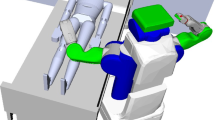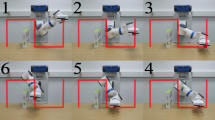Abstract
In highly constrained settings, e.g., a tentacle-like medical robot maneuvering through narrow cavities in the body for minimally invasive surgery, it may be difficult or impossible for a robot with a generic kinematic design to reach all desirable targets while avoiding obstacles. We introduce a design optimization method to compute kinematic design parameters that enable a single robot to reach as many desirable goal regions as possible while avoiding obstacles in an environment. Our method appropriately integrates sampling-based motion planning in configuration space into stochastic optimization in design space so that, over time, our evaluation of a design’s ability to reach goals increases in accuracy and our selected designs approach global optimality. We prove the asymptotic optimality of our method and demonstrate performance in simulation for (1) a serial manipulator and (2) a concentric tube robot, a tentacle-like medical robot that can bend around anatomical obstacles to safely reach clinically-relevant goal regions.







Similar content being viewed by others
Notes
In fact, for any objective that can be defined with respect to a set of points on the robot, we can define the mapping f as \(f(\mathbf {d}, \mathbf {q}, \mathbf {k}) \mapsto \mathrm {Shape}(\mathbf {d}, \mathbf {q},\mathbf {k})\) for any objective-specific \({\mathcal {K}}_\mathrm {reach}\subseteq {\mathcal {K}}_\mathrm {robot}\).
References
Baykal, C., & Alterovitz, R. (2017) Asymptotically optimal design of piecewise cylindrical robots using motion planning. In Proceedings of robotics: Science and systems, Cambridge, MA. https://doi.org/10.15607/RSS.2017.XIII.020
Baykal, C., Torres, L. G., & Alterovitz, R. (2015) Optimizing design parameters for sets of concentric tube robots using sampling-based motion planning. In Proceedings of the IEEE/RSJ international conference on intelligent robots and systems (IROS) (pp. 4381–4387).
Ben-Ameur, W. (2004). Computing the initial temperature of simulated annealing. Computational Optimization and Applications, 29(3), 369–385.
Bergeles, C., Gosline, A. H., Vasilyev, N. V., Codd, P., del Nido, P. J., & Dupont, P. E. (2015). Concentric tube robot design and optimization based on task and anatomical constraints. IEEE Transactions on Robotics, 31(1), 67–84.
Burgner, J., Gilbert, H. B., & Webster III, R. J. (2013). On the computational design of concentric tube robots: Incorporating volume-based objectives. In Proceedings of the IEEE international conference on robotics and automation (ICRA) (pp. 1185–1190).
Burgner-Kahrs, J. (2015). Task-specific design of tubular continuum robots for surgical applications. In Soft robotics (pp. 222–230). New York: Springer
Burgner-Kahrs, J., Gilbert, H. B., Granna, J., Swaney, P. J., & Webster, III, R. J. (2014). Workspace characterization for concentric tube continuum robots. In Proceedings IEEE/RSJ international conference on intelligent robots and systems (IROS) (pp. 1269–1275).
Chocron, O. (2008). Evolutionary design of modular robotic arms. Robotica, 26(3), 323–330.
Denarie, L., Molloy, K., Vaisset, M., Siméon, T., & Cortés, J. (2016). Combining system design and path planning. In Proceedings of the workshop on the algorithmic foundations of robotics (WAFR).
Dupont, P. E., Lock, J., Itkowitz, B., & Butler, E. (2010). Design and control of concentric-tube robots. IEEE Transactions on Robotics, 26(2), 209–225.
Durrett, R. (2010). Probability: Theory and examples. Cambridge: Cambridge University Press.
Gilbert, H. B., Rucker, D. C., & Webster, III, R. J. (2013). Concentric tube robots: The state of the art and future directions. In International symposium on robotics research (ISRR).
Gilbert, H. B., & Webster, R. J, I. I. I. (2016). Rapid, reliable shape setting of superelastic nitinol for prototyping robots. IEEE Robotics and Automation Letters, 1(1), 98–105.
Ha, J., Park, F. C., & Dupont, P. E. (2014). Achieving elastic stability of concentric tube robots through optimization of tube precurvature. In Proceedings of the IEEE/RSJ international conference on intelligent robots and systems (IROS) (pp. 864–870).
Ha, S., Coros, S., Alspach, A., Kim, J., & Yamane, K. (2017). Joint optimization of robot design and motion parameters using the implicit function theorem. In Proceedings of robotics: Science and systems, Cambridge, MA. https://doi.org/10.15607/RSS.2017.XIII.003
Ingber, L. (1989). Very fast simulated re-annealing. Mathematical and Computer Modelling, 12(8), 967–973.
Ingber, L.: Adaptive simulated annealing (1993). https://www.ingber.com/#ASA. Accessed 15 Jan 2017.
Ingber, L., Petraglia, A., Petraglia, M. R., Machado, M. A. S., et al. (2012). Adaptive simulated annealing. In Stochastic global optimization and its applications with fuzzy adaptive simulated annealing (pp. 33–62). Berlin: Springer
Jing, G., Tosun, T., Yim, M., & Kress-Gazit, H. (2016). An end-to-end system for accomplishing tasks with modular robots. In Proceedings of the Robotics: Science and Systems (RSS).
Karaman, S., & Frazzoli, E. (2011). Sampling-based algorithms for optimal motion planning. International Journal of Robotics Research, 30(7), 846–894.
Katragadda, L. K. (1997). A language and framework for robotic design. Ph.D. thesis, Carnegie Mellon University.
Kuntz, A., Bowen, C., & Baykal, C., et al. (2018). Kinematic design optimization of a parallel surgical robot to maximize anatomical visibility via motion planning. In Proceedings of the IEEE international conference on robotics and automation (ICRA).
LaValle, S. M. (2006). Planning algorithms. Cambridge: Cambridge University Press.
LaValle, S. M., & Kuffner, J. J. (2001). Randomized kinodynamic planning. International Journal of Robotics Research, 20(5), 378–400.
Leger, C. (1999). Automated synthesis and optimization of robot configurations: an evolutionary approach. Ph.D. thesis, Carnegie Mellon University.
Locatelli, M. (2002). Simulated annealing algorithms for continuous global optimization. In Handbook of global optimization (pp. 179–229). Berlin: Springer.
Merlet, J. P. (2005). Optimal design of robots. In Proceedings of the Robotics: Science and Systems (RSS).
Morimoto, T. K., Greer, J. D., Hsieh, M. H., & Okamura, A. M. (2016). Surgeon design interface for patient-specific concentric tube robots. In Proceedings of the IEEE international conference on biomedical robotics and biomechatronics (BioRob) (pp. 41–48).
Morimoto, T. K., & Okamura, A. M. (2016). Design of 3-d printed concentric tube robots. IEEE Transactions on Robotics, 32(6), 1419–1430.
Mulgaonkar, Y., Araki, B., Koh, J. S., Guerrero-Bonilla, L., Aukes, D. M., Makineni, A., Tolley, M. T., Rus, D., Wood, R. J., & Kumar, V. (2016) The flying monkey: A mesoscale robot that can run, fly, and grasp. In Proceedings of the IEEE international conference on robotics and automation (ICRA) (pp. 4672–4679).
Munkres, J. R. (2000). Topology. Upper Saddle River: Prentice Hall.
Park, J., Chang, P., & Yang, J. (2003). Task-oriented design of robot kinematics using the grid method. International Journal of Advanced Robotics, 17(9), 879–907.
Plecnik, M. M., Haldane, D. W., Yim, J. K., & Fearing, R. S. (2017). Design exploration and kinematic tuning of a power modulating jumping monopod. Journal of Mechanisms and Robotics, 9(1), 011009.
Reif, J. H. (1979). Complexity of the mover’s problem and generalizations. In 20th Annual IEEE Symposium on Foundations of Computer Science (pp. 421–427).
Rucker, D. C. (2011). The mechanics of continuum robots: Model-based sensing and control. Ph.D. thesis, Vanderbilt University.
Rus, D., & Tolley, M. T. (2015). Design, fabrication and control of soft robots. Nature, 521(7553), 467–475.
Salle, D., Bidaud, P., & Morel, G. (2004). Optimal design of high dexterity modular MIS instrument for coronary artery bypass grafting. In Proceedings of the IEEE international conference on robotics and automation (ICRA) (pp. 1276–1281).
Taylor, O., & Rodriguez, A. (2017). Optimal shape and motion planning for dynamic planar manipulation. In Proceedings of robotics: Science and systems, Cambridge, MA. https://doi.org/10.15607/RSS.2017.XIII.055.
Torres, L. G., Webster, III, R. J., & Alterovitz, R. (2012). Task-oriented design of concentric tube robots using mechanics-based models. In Proceedings of the IEEE/RSJ international conference on intelligent robots and systems (IROS) (pp 4449–4455)
Vijaykumar, R., Waldron, K. J., & Tsai, M. J. (1986). Geometric optimization of serial chain manipulator structures for working volume and dexterity. International Journal of Robotics Research, 5(2), 91–103.
Wright, C., Buchan, A., Brown, B., Geist, J., Schwerin, M., Rollinson, D., Tesch, M., & Choset, H. (2012). Design and architecture of the unified modular snake robot. In Proceedings of the IEEE international conference on robotics and automation (ICRA) (pp. 4347–4354).
Acknowledgements
We thank Alan Kuntz for his insights and feedback on the analysis, Robert J. Webster III for valuable discussions, and Luis G. Torres for his insights into design optimization and software for evaluating designs.
Author information
Authors and Affiliations
Corresponding author
Additional information
Publisher's Note
Springer Nature remains neutral with regard to jurisdictional claims in published maps and institutional affiliations.
This research was supported in part by the National Science Foundation under Award IIS-1149965 and by the National Institutes of Health under Awards R01EB017467, R21EB017952, and R01EB024864.
This is one of several papers published in Autonomous Robots comprising the “Special Issue on Robotics Science and Systems”.
Rights and permissions
About this article
Cite this article
Baykal, C., Bowen, C. & Alterovitz, R. Asymptotically optimal kinematic design of robots using motion planning. Auton Robot 43, 345–357 (2019). https://doi.org/10.1007/s10514-018-9766-x
Received:
Accepted:
Published:
Issue Date:
DOI: https://doi.org/10.1007/s10514-018-9766-x




